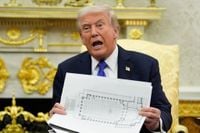In a series of bold and controversial moves, President Donald Trump has set out to leave an indelible mark on the American landscape—literally. As 2025 draws to a close, the president’s unprecedented efforts to reshape Washington, D.C., and the White House itself have become the subject of intense debate, speculation, and, in some circles, outright astonishment. From the demolition of a historic wing of the White House to the proposed construction of a monumental arch inspired by Napoleon’s Arc de Triomphe, Trump’s ambitions for architectural legacy are as grand as they are contentious.
The saga began to crystallize on October 15, 2025, during a ballroom fundraising dinner in the East Room of the White House. There, President Trump held aloft a model of a proposed arch—his own vision for a gateway monument in the nation’s capital. According to ARTnews, the dinner was attended by a who’s who of American industry, including representatives from tech giants like Amazon, Apple, Meta, Google, Microsoft, and Palantir, as well as defense contractor Lockheed Martin. The event was more than just a fundraiser; it was a showcase for Trump’s sweeping plans to transform the capital’s skyline.
The arch, tentatively dubbed the “Arc de Trump,” would be situated across from the Lincoln Memorial, serving as a gateway into Washington from Arlington Memorial Bridge. Trump explained to his guests, “That’s Arlington Memorial Bridge. And at the end of it, you have a circle that was built 150 years ago. You have two columns on one side, two columns on the other, yet in the middle, just a circle. And everyone in the past had said something was supposed to be built there. But a thing called the Civil War interfered. That’s a good reason.” As ARTnews noted, the site is both symbolically and geographically significant, overlooked by Arlington House, the former home of Confederate General Robert E. Lee.
The president’s penchant for monumental architecture is nothing new. For decades, Trump has emblazoned his name on office buildings, hotels, casinos, and golf courses. But, as The New York Times’ Peter Baker observed in his October 30 analysis, 2025 has brought a new level of ambition. “He demolished the East Wing of the White House last week to make way for a vast, gilded Trumpian ballroom,” Baker wrote. “He wants to erect an arch at the entrance to Washington that resembles Napoleon’s Arc de Triomphe. He is even considering having the government issue a new $1 coin with his own face on it—something no president has done in nearly a century.”
The ballroom itself, now under construction, is no less grandiose. According to The Architects’ Journal, the $250 million project is being financed by a combination of federal grants and private donations from the same tech and defense industry donors who attended the October dinner. Designed by McCrery Architects in partnership with AECOM, the ballroom will offer 8,300 square meters of Neoclassical grandeur. The White House has described it as a “much-needed and exquisite addition.” Yet, the project has not been without controversy. The demolition of part of the East Wing—a section steeped in historical significance—has raised eyebrows among preservationists and political opponents alike.
Perhaps unsurprisingly, Trump’s approach to federal architecture has been as sweeping as his construction plans. On his first day back in office in January 2025, Trump issued an executive order mandating that all new federal public buildings “respect traditional and classical architectural heritage.” The order, titled “Promoting Beautiful Federal Civic Architecture,” directed the General Services Administration to submit recommendations for ensuring that federal buildings are “visually identifiable as civic buildings and respect regional, traditional, and classical architectural heritage in order to uplift and beautify public spaces and ennoble the United States and our system of self-government.”
This move has drawn sharp criticism from the American Institute of Architects (AIA), which stated its “strong concerns that mandating architecture styles stifles innovation and harms local communities.” The AIA emphasized, “Our federal buildings across the country must reflect America’s wealth of culture, rich traditions and unique geographic regions.”
Further fueling the controversy, on October 28, Trump abruptly terminated the positions of several independent architects and designers on the Commission of Fine Arts, including Bruce Redman Becker, Peter D Cook, and William J Lenihan. The commission, established in 1910, has long advised the government on plans for memorials, monuments, and public buildings, though it lacks final approval power. According to The Washington Post, it remains unclear whether these commissioners were consulted about the White House ballroom or the proposed arch before their dismissal. An anonymous White House official maintained that “all necessary agencies and entities who need to review the [ballroom] project” were being consulted. Still, the abrupt firings have left many in the architectural community uneasy about the administration’s decision-making process.
Trump’s fascination with the afterlife has also crept into the public discourse. During an August appearance on Fox News’ “Fox & Friends,” he quipped, “I want to try and get to heaven, if possible. I’m hearing I’m not doing well. I am really at the bottom of the totem pole.” As The New York Times’ Baker noted, this rare moment of self-doubt from the president has prompted speculation about his motivations. “If absolution is out of reach, perhaps there are more achievable ways of living beyond his natural time on this earth,” Baker mused, suggesting that Trump’s drive to create grand monuments may be an attempt at immortality through legacy rather than redemption.
The proposed “Arc de Trump” would coincide with the 250th anniversary of America’s founding, a fact not lost on its proponents or detractors. Triumphal arches have historically commemorated military victories and national achievements, from ancient Rome to Napoleon’s France. Trump, a lifelong real estate developer, seems determined to write his own chapter in this tradition. “It’s so relaxing for me. Real estate is relaxing. For a lot of people, real estate is a very trying business. I’ve always liked it. I’ve always done well with it,” he told guests at the White House dinner, as reported by ARTnews.
Yet, as with so many of Trump’s ventures, questions abound. Details about the cost, funding sources, and required permits for the arch remain elusive. The administration’s willingness to sideline established advisory bodies and override traditional design processes has only heightened the sense of uncertainty. Meanwhile, Trump’s on-again, off-again musings about seeking a third term—despite constitutional prohibitions—underscore his reluctance to step away from the spotlight.
In the end, whether Trump’s monuments will stand the test of time or become cautionary tales of presidential hubris remains to be seen. For now, the capital is abuzz with construction, controversy, and a sense that history—like architecture—is being rewritten before our eyes.





